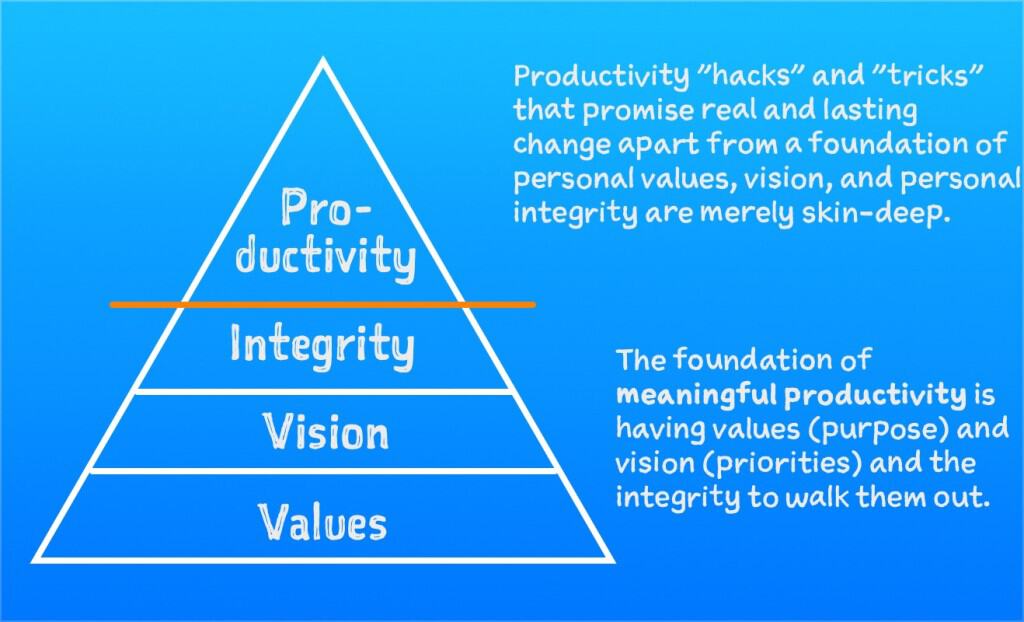It’s the end of the day.
I work downstairs, so for me, closing up the office is as simple as stepping away from my desk and walking up the half-flight of stairs.
I’ve had this 30-second commute since 2011, which is when I quit my job to focus full-time on writing here at shawnblanc.net.
Despite the complete autonomy for how I spend my time, doing my best creative work is still a daily practice.
There have been seasons in my life when, at the end of my day, I walk up that half-flight of steps with a feeling that my day was a waste. I just spent hours at work, yet feel completely unsatisfied.
Usually this it’s because I got caught up in the seemingly urgent and pressing issues of the day. Things didn’t go as well as I’d hoped they would. I tried to make progress on a meaningful task but just kept hitting a wall.
It’s now been nearly five years since I began working for myself and working from home. And over the years, it has become ever more important to me that spend my time well. I’ve learned a bit about how I work (and how I should best be spending my time) so I have fewer “wasted days”.
For me, spending my time well means spending my time creating.
But that’s easier said than done.
Since I work for myself, I’m also in charge of all the budgeting and bookkeeping, server admin, customer support, marketing, income projections, content strategy, and more. Not to mention, you know, actually doing the work of writing and publishing.
I could spend hours and hours every day on email and other admin tasks. Or, I could spend hours every day making something.
This is not news, of course. You’re in the same position.
It’s the age-old conundrum of “urgent versus important”, right? We want to spend our time on work that’s important, not just work that’s all shiny right now but won’t matter one lick tomorrow.
Where everything changed for me was the day I realized that I alone was in charge of how I spent my time.
It’s I who has to choose how to spend my time. I can spend it on silly things or I can spend it on awesome things.
Sometimes, silly and awesome intersect (such as here).
But usually, when doing my most important work, it’s, well, it’s work.
Which is why it can be so easy to become desensitized to shallow work. All the email and admin tasks are easy to do, and I fool myself into thinking that checking email throughout the day is a totally fine thing to do — I’m being “productive”.
Below are some thoughts on what I call “Meaningful Productivity” — what it is, what it isn’t, and why it matters.
Productivity Isn’t Just for Business-y Stuff
Is the stay-at-home dad who spends most of his day changing diapers and cleaning up messes any less productive than his wife who is the CEO of a charity organization?
Of course not. Each is productive in his or her area of responsibility.
Productivity tends to be defined by how well we use our task management systems, how organized our calendar app is, how fast we can blaze through a pile of emails, and how fluidly we flow from one meeting to the next.
But those metrics skew toward rewarding effective busywork while giving little dignity to meaningful work.
Which is why I want to define productivity differently. With less of a focus on our party trick of balancing many plates at once, and more of a focus on our ability to consistently give our time and attention to the things which are most important.
Productivity is Not Primarily About Efficiency
Productivity, in and of itself, is just a metric for efficiency.
Yes, efficiency is awesome. But what’s more awesome is spending your time on the right things. Things of substance and value.
Besides. Even though productivity measures efficiency, it’s a sliding scale.
How fast you can get something done is not always the proper metric. Sometimes I spend 30 minutes or more on a single email. Because it needs to be worded just right. Sometimes I can fire off a reply in less than a minute.
Speed alone doesn’t matter. What matters was if I communicated the best I could.
While there is obviously no point in spending 30 minutes on a single email that could just as easily be written in 1. It’s equally poor form to spend just 1 minute on an email that requires more time and thought than that.
My point being: rather than concerning ourselves mostly with tips and tricks, we should make sure we’re actually spending our time well in the first place. Tips and tricks can help (and they’re fun), but they aren’t the main topic.
Meaningful Productivity Thrives on Deep Work, Focused Attention, and Relationships
More often than not, our best work is accomplished during times when we are in the zone. Or as Mihaly Csikszentmihalyi says, when we are in a state of flow.
Focused Work, looks like an hour or more of single tasking. Practicing a musical instrument. Practicing a physical activity. Writing. Painting. Planning and architecting. Coding. Designing. Etc.
Shallow work, looks like “multitasking”. Email correspondence. Checking our social network timelines. Browsing the news. Etc.
We can’t pit deep work and shallow work against one another. Because they’re both important in their own right.
However, neither should we replace the former with the latter.
Sure, there are some people whose most important work is to live in their email inbox — communicating with others. For most of us, if all we did was check email we’d be out of a job.
And yet, when most of us sit down to “work” the first thing we do is open our email program.
Why do we open up our email? Because we don’t know what else to do.
It’s one thing to show up and set aside a few hours for focused work. It’s another thing to know what to work on during that time.
When you realize that you’re in control of your time and attention, you’ll see that you have two roles: boss and worker.
You are both the planner and the executer. The thinker and the doer.
Don’t try to do both of these jobs at the same time. Have planning, thinking, strategizing time. And then, later, have working and doing time.
For example, if you’re going to write something, don’t sit down when it’s time to write and ask yourself, “what shall I write about now?”
Know ahead of time what your writing topic will be. This way, when you sit down to write you have just one task: to write.
Meaningful Productivity is a Byproduct of Clarity
You can’t spend your time doing work that matters if you don’t know what matters in the first place.
Productivity hacks, daily routines, automation tools, and the like are all great. But they are a means for optimizing how you’re already spending your time. They’re just faster horses.
And what good is a faster horse if you’re on the wrong road, headed to the wrong place?
We need clarity about who we are, what our values are, our vision for life, what’s important, and what we can do every day to stay steady in our aim of doing our best creative work.
You Have to Start With Meaning
If true (Meaningful) Productivity is doing that which is most important, then it means that productivity is not ultimately based on efficiency, but rather vision and values.
This is why having a life vision and life goals is so powerful. With them, you can define what it looks like to actually be productive (not just busy).
It is in the area of work that this fight to be meaningfully productive is perhaps the most difficult. Our offices, workflows, managers, reports, and meetings all center around the act of being busy with little in place to recognize or reward meaningful productivity.

Productivity “hacks” and “tricks” that promise real and lasting change apart from a foundation of personal values, vision, and integrity are merely skin deep.
The foundation of meaningful productivity is having values (or purpose), vision (or priorities), and the personal integrity to walk them out.
Ask yourself this:
- What is most important to you in life?
- What are your most valuable relationships?
- What are the values you most want to impart to others?
Answer those questions and you’ve got a strong foundation to direct how you spend your time and energy. Because now you can measure your tasks against your vision and values and use them to define meaningful productivity for your life.
* * *
Speaking of… If this topic interests you, then you should sign up for the free class I’m hosting in a few weeks. You can find out more here.

